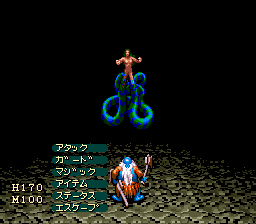 |
| U.S. Version title screen |
 |
| Japanese version title screen. |
Well, as you can see from these two screenshots, the first major difference is the title screen, although the U.S. version's is actually blocked by a transparency effect. If you disable it, then it looks exactly the same as the Japanese version's title screen.
 |
| U.S. version |
 |
| Japanese version |
For one, in the U.S. version, the colors are brighter and more vivid in most locations, in the Japanese version they're washed-out and muted. You can also gather from the above screenshots that Wilme and Lejes (Willme and Lejees in the Japanese version) also had their sprites altered. In the Japanese version, Lejes looks like a demon on the map screens, but in battles, at least from the front, he looks like a male Twi'lek from Star Wars, to quote TCRF.net. Wilme got censored and forced to wear underwear and had his unicorn horn removed, and he also went nude in the Japanese version.
 |
| Wilme's Japanese battle sprite. |
 |
| Lejes' Japanese battle sprite. |
Of course, those two weren't the only characters to get overhauls to their sprites in the international versions.
The four screenshots above are the U.S. sprites for certain monsters. In the Japanese version, however...
They were either nude, or in the Sword's case, looking a bit too much like religious symbols. Or at least, that's the theory. You have to remember that this game came out at a time when Nintendo was draconian with its censorship policies. Oh, yeah? Even the final boss' sprite got altered for the U.S. release!
In the U.S. version, Gorsia is blue and has a much wider lower-body, while in the Japanese version, he's yellow and has a smaller lower-body.
Probably the most significant difference is the fact that every ten levels you gain in the Japanese version, all of your stat growths will get a +1 to them, so if you have, say, 3-5 points for a stat growth, then levels 1-9 will be 3-5 points gained for that stat, 10-19 will be 4-6, 20-29 will be 5-7, 30-39 will be 6-8, etc. In the U.S. version, however, you keep the same stat growths all throughout. This is what makes The 7th Saga so hard. You see, in Elnard, your main character's stats grow at the same rate the other apprentices do, meaning that everything is mostly fair and square in combat. In the U.S. version, however, your stats grow at a very slowed down pace while the apprentices not under your control retain their Japanese stat growths, and chances are, the one who gets the Sky Rune will obliterate you. They also have access to equipment none of them should have yet. Of course, that goes for both versions of the game, U.S. and Japanese.
EDIT: Thanks to Reddit user, stripes_by_proxy, I forgot to put this in, but the enemies also got boosts to some of their stats, for example, in Elnard Romus only has about 130 HP. In The 7th Saga, his HP got boosted up to about 300.
The localization team wasn't totally without their mercy, however. Certain items in the U.S. version weren't there in the Japanese version, case in point, the mirror you can find at the beginning of the game near the bed.
 |
| You find a mirror here in the U.S. version... |
 |
| ...but in the Japanese version, there's nothing there at all! |
To give you a comparison for how different your stats will be in each version.
 |
| U.S. version |
 |
| U.S. Version |
 |
| Japanese version |
 |
| Japanese version |
As you can see, in both versions, I had Wilme go it alone. In the U.S. version, he turned out mostly okay, except in Magic, but in the Japanese version, he was a beast! Seriously, compare the stats between the two versions, and I think it's pretty clear which version is the easier version.
EDIT: One last change between the versions that I forgot to mention is that the menu selection sound is different in the Japanese version, and so is the sound doors make when you open them.
EDIT: One last change between the versions that I forgot to mention is that the menu selection sound is different in the Japanese version, and so is the sound doors make when you open them.
If you want to see all of the bosses fighting in-game, then go here.
This article, including all text and screenshots, is © 2019 Jestan Diams. The 7th Saga and Elnard belong to Enix (technically Square Enix now, but whatever) and Gameplan 21. All 7th Saga and Elnard characters © Square Enix and Gameplan 21. All original characters, names, etc., are © and ™ Jestan Diams. All rights reserved.
















Appreciate the comparisons here. 7th Saga/Elnard is one of my all-time favorite games.
ReplyDeleteHow so?
ReplyDeleteGorsia's change might be because Gorsia's thunder bolt attack animation shows him literally pissing on you. Sadly, the change wasn't an improvement.
ReplyDeleteI think you might enjoy the Lufia series! GOAT for me
ReplyDeleteVid gone
ReplyDeleteApologies. I deleted that video about three years ago. I'll redo it, eventually. Maybe.
Delete